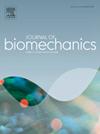Using dynamic ultrasound to assess Achilles tendon mechanics during running: The effect on running pattern and muscle–tendon junction tracking
IF 2.4
3区 医学
Q3 BIOPHYSICS
引用次数: 0
Abstract
Achilles tendon strain can be quantified using dynamic ultrasound, but its use in running is limited. Minimal effects on running pattern and acceptable test–retest reliability of muscle–tendon junction (MTJ) tracking are prerequisites for ultrasound use during running. We aimed to assess (i) the effect of wearing an ultrasound transducer on running pattern and (ii) the test–retest reliability of MTJ tracking during running. Sixteen long-distance runners (nine injury-free, seven with Achilles tendinopathy) ran at different speeds on an instrumented treadmill with a 10-camera system tracking skin-mounted retroreflective markers, first without and then with an ultrasound transducer attached to the lower leg to track the MTJ of the gastrocnemius medialis. Spatiotemporal parameters, joint kinematics and kinetics were compared between conditions using mixed ANOVAs and paired t-tests. MTJ tracking was performed manually twice by three raters in ten participants. Variability and standard error of measurement (SEM) quantified the inter- and intra-tester test–retest reliability. The running pattern was not affected by wearing the ultrasound transducer, except for significantly less knee flexion during midstance (1.6°) and midswing (2.9°) found when wearing the transducer. Inter-rater and intra-rater SEMs for MTJ tracking to assess the tendon strain (0.43%, and 0.56%, respectively) were about four times as low as between-group differences presented in literature. The minimal effects found on the running pattern and acceptable test–retest reliability indicates that dynamic ultrasound during running can be appropriately used to study Achilles tendon mechanics and thereby help improve our understanding of Achilles tendon behavior during running, injury development and recovery.
使用动态超声波评估跑步过程中的跟腱力学:对跑步模式和肌肉肌腱连接跟踪的影响。
跟腱应变可通过动态超声波进行量化,但其在跑步中的应用有限。在跑步过程中使用超声波的先决条件是对跑步模式的影响最小以及肌肉-肌腱交界处(MTJ)跟踪的测试-复测可靠性可接受。我们的目的是评估:(i) 佩戴超声波传感器对跑步模式的影响;(ii) 跑步时追踪 MTJ 的重测可靠性。16 名长跑运动员(9 人未受伤,7 人患有跟腱病)在装有仪器的跑步机上以不同的速度跑步,跑步机上装有 10 个摄像头系统,跟踪安装在皮肤上的反向反射标记。使用混合方差分析和配对 t 检验比较了不同条件下的时空参数、关节运动学和动力学。MTJ 跟踪由三名评定者对 10 名参与者进行两次人工跟踪。变异性和标准测量误差(SEM)量化了测试者之间和测试者内部测试-再测试的可靠性。跑步模式不受佩戴超声波传感器的影响,只是在佩戴传感器时,膝关节中段屈曲(1.6°)和中段屈曲(2.9°)明显减少。MTJ 跟踪评估肌腱应变的评分者间和评分者内 SEM 值(分别为 0.43% 和 0.56%)比文献中的组间差异低约四倍。对跑步模式的影响极小,测试-重复可靠性也可接受,这表明跑步过程中的动态超声波可适当用于研究跟腱力学,从而帮助我们更好地了解跟腱在跑步、损伤发展和恢复过程中的行为。
本文章由计算机程序翻译,如有差异,请以英文原文为准。
求助全文
约1分钟内获得全文
求助全文
来源期刊

Journal of biomechanics
生物-工程:生物医学
CiteScore
5.10
自引率
4.20%
发文量
345
审稿时长
1 months
期刊介绍:
The Journal of Biomechanics publishes reports of original and substantial findings using the principles of mechanics to explore biological problems. Analytical, as well as experimental papers may be submitted, and the journal accepts original articles, surveys and perspective articles (usually by Editorial invitation only), book reviews and letters to the Editor. The criteria for acceptance of manuscripts include excellence, novelty, significance, clarity, conciseness and interest to the readership.
Papers published in the journal may cover a wide range of topics in biomechanics, including, but not limited to:
-Fundamental Topics - Biomechanics of the musculoskeletal, cardiovascular, and respiratory systems, mechanics of hard and soft tissues, biofluid mechanics, mechanics of prostheses and implant-tissue interfaces, mechanics of cells.
-Cardiovascular and Respiratory Biomechanics - Mechanics of blood-flow, air-flow, mechanics of the soft tissues, flow-tissue or flow-prosthesis interactions.
-Cell Biomechanics - Biomechanic analyses of cells, membranes and sub-cellular structures; the relationship of the mechanical environment to cell and tissue response.
-Dental Biomechanics - Design and analysis of dental tissues and prostheses, mechanics of chewing.
-Functional Tissue Engineering - The role of biomechanical factors in engineered tissue replacements and regenerative medicine.
-Injury Biomechanics - Mechanics of impact and trauma, dynamics of man-machine interaction.
-Molecular Biomechanics - Mechanical analyses of biomolecules.
-Orthopedic Biomechanics - Mechanics of fracture and fracture fixation, mechanics of implants and implant fixation, mechanics of bones and joints, wear of natural and artificial joints.
-Rehabilitation Biomechanics - Analyses of gait, mechanics of prosthetics and orthotics.
-Sports Biomechanics - Mechanical analyses of sports performance.
 求助内容:
求助内容: 应助结果提醒方式:
应助结果提醒方式:


